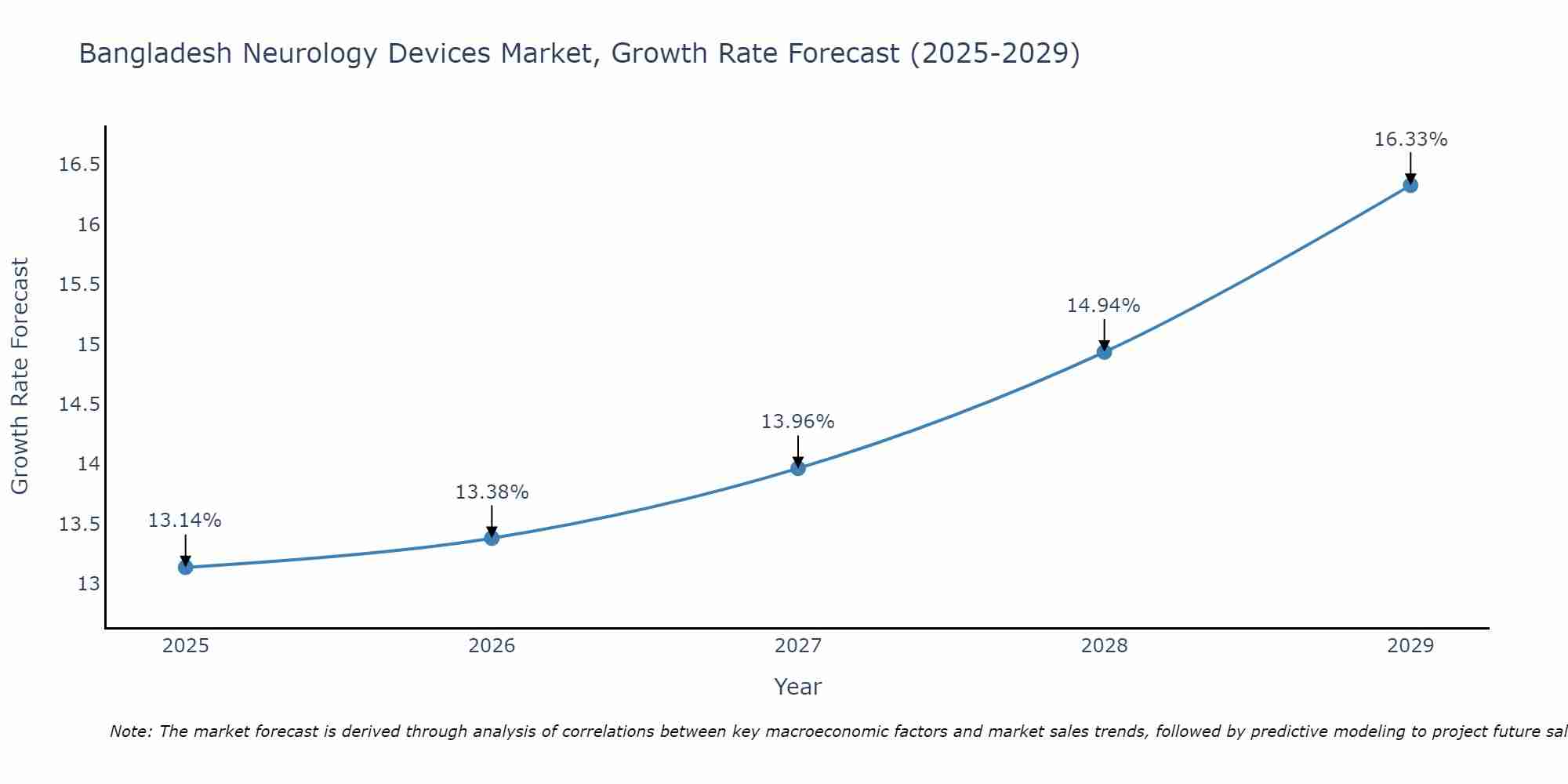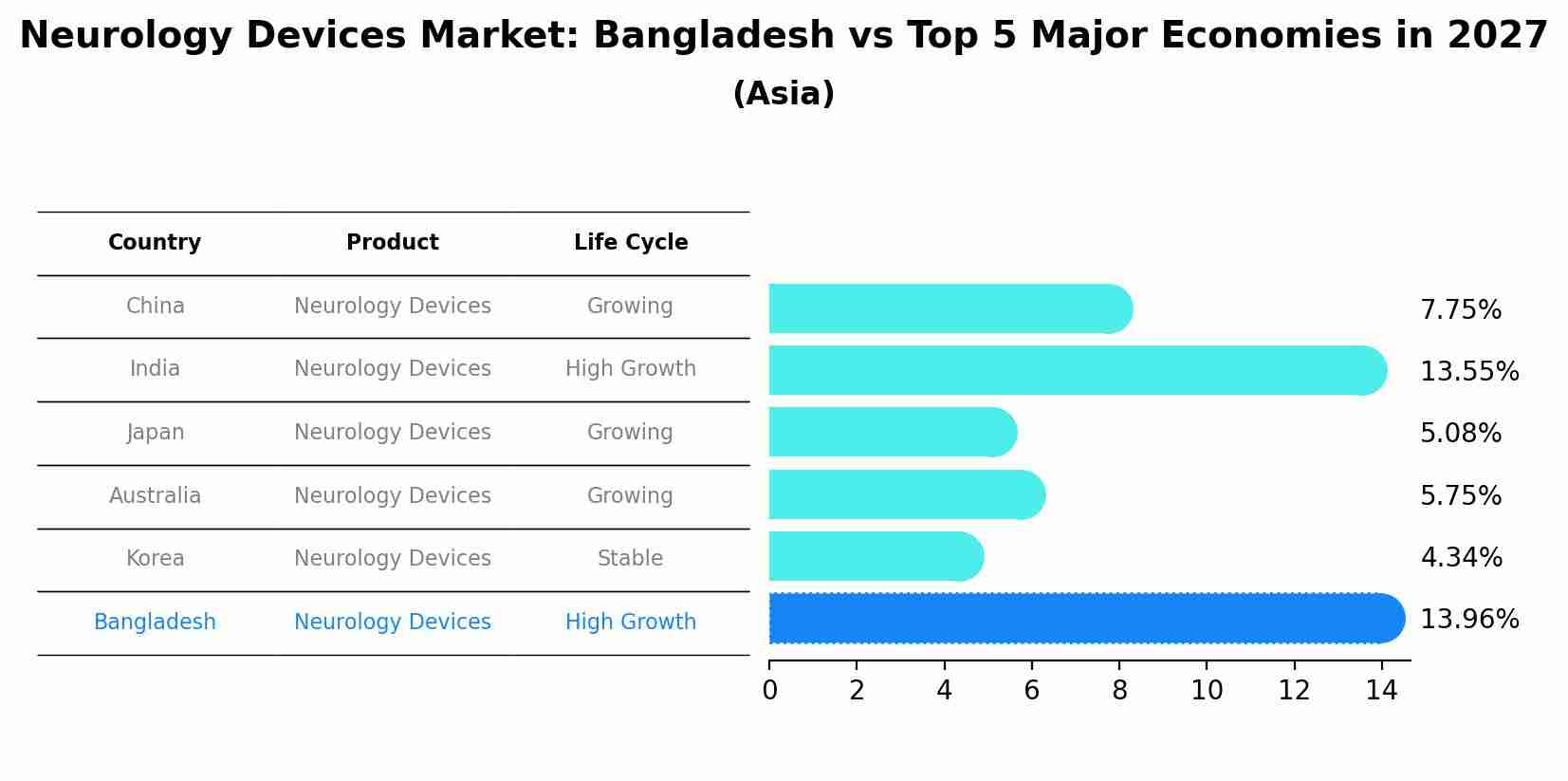Bangladesh Neurology Devices Market (2025-2031) Outlook | Analysis, Trends, Companies, Forecast, Share, Revenue, Size, Industry, Growth & Value
| Product Code: ETC367652 | Publication Date: Aug 2022 | Updated Date: Apr 2025 | Product Type: Market Research Report | |
| Publisher: 6Wresearch | Author: Shubham Padhi | No. of Pages: 75 | No. of Figures: 35 | No. of Tables: 20 |
Bangladesh Neurology Devices Market Size Growth Rate
The Bangladesh Neurology Devices Market is likely to experience consistent growth rate gains over the period 2025 to 2029. The growth rate starts at 13.14% in 2025 and reaches 16.33% by 2029.

Neurology Devices Market: Bangladesh vs Top 5 Major Economies in 2027 (Asia)
Bangladesh's Neurology Devices market is anticipated to experience a high growth rate of 13.96% by 2027, reflecting trends observed in the largest economy China, followed by India, Japan, Australia and South Korea.

Bangladesh Neurology Devices Market Overview
The neurology devices market is expanding in Bangladesh as healthcare providers seek advanced medical technologies to diagnose, treat, and monitor neurological disorders and conditions. Neurology devices encompass a wide range of diagnostic imaging systems, therapeutic devices, monitoring equipment, and surgical instruments used in neurology clinics, hospitals, and research laboratories. With the increasing prevalence of neurological disorders such as stroke, epilepsy, Alzheimer`s disease, and Parkinson`s disease, there is a growing demand for neurology devices to improve patient outcomes and quality of life. As Bangladesh invests in healthcare infrastructure and expands access to specialized medical services, the neurology devices market is expected to grow, driven by advancements in technology and rising healthcare expenditures.
Drivers of the market
The rising prevalence of neurological disorders and the aging population are driving the demand for neurology devices in Bangladesh. These devices include diagnostic equipment, therapeutic devices, and monitoring systems used in the diagnosis, treatment, and management of neurological conditions such as stroke, epilepsy, and Parkinson`s disease.
Challenges of the market
Challenges involve regulatory approval, reimbursement policies, and competition from international manufacturers. While neurology devices offer essential diagnostic and therapeutic solutions for neurological disorders, manufacturers may face challenges in obtaining regulatory clearance for new devices, securing reimbursement from healthcare payers, and differentiating their products in a competitive market.
Government Policy of the market
In support of healthcare innovation and access to advanced medical technologies, the government has implemented policies to promote the neurology devices market in Bangladesh. These policies may include regulatory approval processes for medical devices, incentives for investment in neurology device manufacturing and distribution, and capacity-building programs for healthcare professionals.
Key Highlights of the Report:
- Bangladesh Neurology Devices Market Outlook
- Market Size of Bangladesh Neurology Devices Market, 2024
- Forecast of Bangladesh Neurology Devices Market, 2031
- Historical Data and Forecast of Bangladesh Neurology Devices Revenues & Volume for the Period 2021-2031
- Bangladesh Neurology Devices Market Trend Evolution
- Bangladesh Neurology Devices Market Drivers and Challenges
- Bangladesh Neurology Devices Price Trends
- Bangladesh Neurology Devices Porter's Five Forces
- Bangladesh Neurology Devices Industry Life Cycle
- Historical Data and Forecast of Bangladesh Neurology Devices Market Revenues & Volume By Product for the Period 2021-2031
- Historical Data and Forecast of Bangladesh Neurology Devices Market Revenues & Volume By Neurostimulation Devices for the Period 2021-2031
- Historical Data and Forecast of Bangladesh Neurology Devices Market Revenues & Volume By Neurosurgery Devices for the Period 2021-2031
- Historical Data and Forecast of Bangladesh Neurology Devices Market Revenues & Volume By Interventional Neurology Devices for the Period 2021-2031
- Historical Data and Forecast of Bangladesh Neurology Devices Market Revenues & Volume By Cerebrospinal fluid management devices for the Period 2021-2031
- Historical Data and Forecast of Bangladesh Neurology Devices Market Revenues & Volume By Others for the Period 2021-2031
- Historical Data and Forecast of Bangladesh Neurology Devices Market Revenues & Volume By End User for the Period 2021-2031
- Historical Data and Forecast of Bangladesh Neurology Devices Market Revenues & Volume By Hospitals for the Period 2021-2031
- Historical Data and Forecast of Bangladesh Neurology Devices Market Revenues & Volume By Ambulatory surgery centers for the Period 2021-2031
- Historical Data and Forecast of Bangladesh Neurology Devices Market Revenues & Volume By Neurology clinics for the Period 2021-2031
- Bangladesh Neurology Devices Import Export Trade Statistics
- Market Opportunity Assessment By Product
- Market Opportunity Assessment By End User
- Bangladesh Neurology Devices Top Companies Market Share
- Bangladesh Neurology Devices Competitive Benchmarking By Technical and Operational Parameters
- Bangladesh Neurology Devices Company Profiles
- Bangladesh Neurology Devices Key Strategic Recommendations
Frequently Asked Questions About the Market Study (FAQs):
- Single User License$ 1,995
- Department License$ 2,400
- Site License$ 3,120
- Global License$ 3,795
Search
Thought Leadership and Analyst Meet
Our Clients
Related Reports
- Afghanistan Apparel Market (2026-2032) | Growth, Outlook, Industry, Segmentation, Forecast, Size, Companies, Trends, Value, Share, Analysis & Revenue
- Canada Oil and Gas Market (2026-2032) | Share, Segmentation, Value, Industry, Trends, Forecast, Analysis, Size & Revenue, Growth, Competitive Landscape, Outlook, Companies
- Germany Breakfast Food Market (2026-2032) | Industry, Share, Growth, Size, Companies, Value, Analysis, Revenue, Trends, Forecast & Outlook
- Australia Briquette Market (2025-2031) | Growth, Size, Revenue, Forecast, Analysis, Trends, Value, Share, Industry & Companies
- Vietnam System Integrator Market (2025-2031) | Size, Companies, Analysis, Industry, Value, Forecast, Growth, Trends, Revenue & Share
- ASEAN and Thailand Brain Health Supplements Market (2025-2031) | Strategy, Consumer Insights, Analysis, Investment Trends, Opportunities, Growth, Size, Share, Industry, Revenue, Segments, Value, Segmentation, Supply, Forecast, Restraints, Outlook, Competition, Drivers, Trends, Demand, Pricing Analysis, Competitive, Strategic Insights, Companies, Challenges
- ASEAN Bearings Market (2025-2031) | Strategy, Consumer Insights, Analysis, Investment Trends, Opportunities, Growth, Size, Share, Industry, Revenue, Segments, Value, Segmentation, Supply, Forecast, Restraints, Outlook, Competition, Drivers, Trends, Demand, Pricing Analysis, Competitive, Strategic Insights, Companies, Challenges
- Europe Flooring Market (2025-2031) | Outlook, Share, Industry, Trends, Forecast, Companies, Revenue, Size, Analysis, Growth & Value
- Saudi Arabia Manlift Market (2025-2031) | Outlook, Size, Growth, Trends, Companies, Industry, Revenue, Value, Share, Forecast & Analysis
- Uganda Excavator, Crane, and Wheel Loaders Market (2025-2031) | Strategy, Consumer Insights, Analysis, Investment Trends, Opportunities, Growth, Size, Share, Industry, Revenue, Segments, Value, Segmentation, Supply, Forecast, Restraints, Outlook, Competition, Drivers, Trends, Demand, Pricing Analysis, Competitive, Strategic Insights, Companies, Challenges
Industry Events and Analyst Meet
Whitepaper
- Middle East & Africa Commercial Security Market Click here to view more.
- Middle East & Africa Fire Safety Systems & Equipment Market Click here to view more.
- GCC Drone Market Click here to view more.
- Middle East Lighting Fixture Market Click here to view more.
- GCC Physical & Perimeter Security Market Click here to view more.
6WResearch In News
- Doha a strategic location for EV manufacturing hub: IPA Qatar
- Demand for luxury TVs surging in the GCC, says Samsung
- Empowering Growth: The Thriving Journey of Bangladesh’s Cable Industry
- Demand for luxury TVs surging in the GCC, says Samsung
- Video call with a traditional healer? Once unthinkable, it’s now common in South Africa
- Intelligent Buildings To Smooth GCC’s Path To Net Zero


















